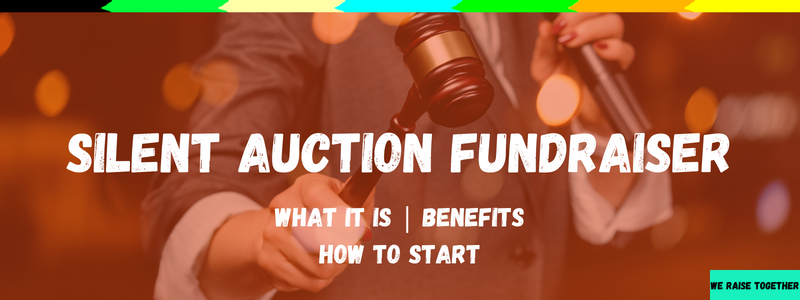Are you looking for a way to raise money for your organization? A silent auction fundraiser could be the perfect way!
This creative approach to fundraising provides an exciting way to bring your community together by auctioning off items and experiences.
In this ultimate guide, we’ll explore what a silent auction fundraiser is, how it works, and its many benefits.
We’ll even provide some expert tips at the end to help you plan the most fun and profitable auction possible.
So, if you’re curious about how this type of event works or are considering hosting one, read on!
Table of Contents
- What Is A Silent Auction Fundraiser?
- How Does A Silent Auction Work?
- 10 Benefits To Running A Silent Auction
- 1. Raise Money For A Good Cause
- 2. Engage Supporters and Donors
- 3. Provide Unique Items and Experiences
- 4. Build Community and Relationships
- 5. Flexibility and Scalability
- 6. Simple Logistics Compared to Other Fundraisers
- 7. Increase Awareness and Visibility
- 8. Boost Donor Retention and Acquisition
- 9. Foster Friendly Competition Among Donors
- 10. Create a Fun and Memorable Event
- Silent Auction Rules
- How To Throw A Silent Auction
- 2. Procure Silent Auction Items
- 3. Promote Your Silent Auction
- 4. Set Up The Silent Auction
- 5. Monitor Bidding
- 6. Close the Auction and Get Paid
- 7. Evaluate Your Silent Auction
What Is A Silent Auction Fundraiser?
A silent auction fundraiser is an event where items or experiences are auctioned off to the highest bidder.
However, unlike a traditional auction, the bidding is done silently, typically using a bid sheet or mobile app.
In this peer to peer fundraising model, you display the items up for auction on tables or on a wall. Then, attendees browse the items and bid on the ones they’re interested in.
You record bids on bid sheets or mobile app, and at the end of the auction, the highest bidder for each item is announced as the winner.
Some of the advantages of a silent auction fundraiser include the:
- Ability to involve a large number of people
- Opportunity to offer a wide variety of items and experiences for bidding
- Ability to generate significant revenue for your cause
Additionally, you can hold silent auctions in a variety of settings, from formal galas to casual community events, making them a versatile fundraising option.
Online Silent Auctions
An online silent auction fundraiser is similar to a traditional silent auction, but it takes place virtually.
Instead of physically displaying items or experiences, you list items on a website or mobile app, along with their descriptions and starting bid amounts.
Participants can browse the items and place their bids online, just as they would in a traditional silent auction.
Bidding typically takes place over a set period of time. Then, participants are notified of updates to their bids or if they’ve been outbid.
One of the advantages of an online silent auction fundraiser is that people can access it from all over the world, not just those physically present.
This can increase the potential audience for the fundraiser, leading to higher bids and more money raised for the cause.
Additionally, an online silent auction can be less labor-intensive than a traditional silent auction.
After all, there’s no need to physically set up and manage the auction items, which also makes it a more cost-effective option.
How Does A Silent Auction Work?

In a silent auction, you put items or experiences up for bid. Then, attendees write down their bids or record it on an app.
Unlike a traditional auction where a professional auctioneer leads the bidding, silent auctions typically have no verbal interaction between bidders.
Here’s how a typical silent auction works:
- Items up for auction are displayed with a description and starting bid amount.
- Guests walk around and look at the items on display. If they’re interested in an item, they write down their bid on the bid sheet next to the item or record it on an app.
- Bidding continues for a set amount of time, usually a few hours. Guests can return to the bid sheets throughout the event to see if they’ve been outbid. Then, they can place higher bids if they want.
- At the end of the auction, the highest bidder for each item is declared the winner.
- Guests pay for their items and take them home.
It’s worth noting that the success of a silent auction depends on factors like:
- The quality of the items up for bid
- The number of attendees
- How well the event is promoted
10 Benefits To Running A Silent Auction
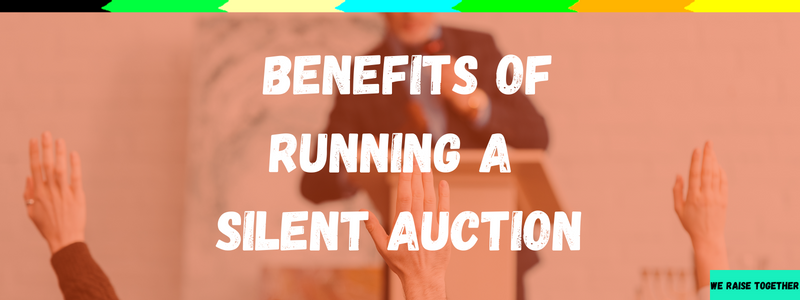
Silent auctions allow you to offer a wide range of items, services, and experiences for auction.
So, it’s no wonder why silent auctions can be so successful!
In this section, we’ll explore 10 benefits to running a silent auction that you may not have considered.
1. Raise Money For A Good Cause

One of the best reasons to run a silent auction is to raise money for a good cause.
They’re a great way to bring in donations from supporters excited about your organization’s mission.
By offering a range of desirable items or experiences for auction, you can incentivize supporters to give more than they might otherwise.
Additionanlly, silent auctions are particularly effective when combined with other fundraising activities, such as:
- Ticket sales
- Raffles
- Donation drives
By combining multiple fundraising activities, you can create a more can attract a wider range of supporters and generate more overall donations.
When planning a silent auction for fundraising, it’s important to set clear fundraising goals and strategies.
For example, this may involve researching and selecting high-value auction items that are likely to generate interest and high bids.
However, it might also involve promoting the event widely to attract as many bidders as possible.
2. Engage Supporters and Donors
Running a silent auction can build stronger connections with your supporters and create a greater sense of community around your cause.
They can attract a wide range of supporters, from loyal donors to new supporters curious about your organization.
In addition, they’re an opportunity for supporters to connect with one another and with your organization or nonprofit.
This allows you to deepen relationships and build a stronger network.
Silent auctions can also be a powerful tool for acquiring new donors.
By attracting people who may not have heard of your organization before, you can bring in new supporters interested in your mission who want to learn more.
To make the most of your fundraiser, it’s key to create an event that’s both fun and informative.
For example, you might consider incorporating elements such as:
- Live music
- Food and drink
- Interactive activities that help guests learn more about your organization’s work and impact
A successful silent auction can help your organization build a more engaged and committed donor base. In turn, this helps you achieve your mission over the long term.
3. Provide Unique Items and Experiences

Running a silent auction is an excellent way to provide unique items and experiences to your supporters.
The items you choose to offer can be almost anything, from rare memorabilia to exclusive trips and experiences.
Keep in mind that offering desirable items can help create buzz around your event and attract more bidders. Ultimately, this increases the amount of money raised.
In addition to providing unique items and experiences, a silent auction also offers a chance to showcase the creativity of your organization’s supporters.
For example, think about reaching out to local artists or businesses to see if they’d be willing to donate items or experiences.
This can help create a sense of community around your event and highlight the diversity of your supporters.
Another strategy is offering packages or bundles that combine multiple items or experiences into one auction lot.
For example, you might create a package that includes a luxury vacation package, a gourmet dinner at a top restaurant, and tickets to a popular event.
Combining multiple items into one lot can help create a sense of excitement and exclusivity around that item. In turn, this can help increase its value.
Providing unique items and experiences is a key way to differentiate your silent auction from other fundraising events.
Additionally, it creates a memorable experience for your supporters.
4. Build Community and Relationships
Silent auctions are a low-pressure fundraising method providing an enjoyable platform for donors to offer support.
Unlike live auctions, which can be fast-paced and competitive, silent auctions allow donors to bid at their own pace.
This avoids the pressure of real-time outbidding.
This can be particularly appealing to donors who feel uncomfortable in more high-pressure fundraising environments.
By creating a relaxed atmosphere, you can encourage more people to participate in your auction.
In addition, silent auctions can offer a greater range of bidding options for donors.
While live auctions typically involve bidding in large increments, silent auctions allow for smaller bids and can cater to a wider range of budgets.
This can make it more accessible for a broader range of supporters to participate in the fundraising process.
Another benefit of silent auctions is that they can provide valuable information on your donors’ interests and preferences.
For example, you can track which items receive the most bids and at what prices.
Then, you can use those insights to understand what your supporters are most interested in and inform future fundraising efforts.
5. Flexibility and Scalability

Silent auctions offer a lot of flexibility in terms of when and where they can be held.
Unlike other fundraising events requiring a specific venue or date, you can opt to run an online silent auction almost anywhere, anytime.
This makes them an ideal fundraising option for organizations of all sizes and budgets.
If you have a small organization or limited budget, you can host a silent auction at:
- A local community center
- A Church hall
- Your office space
Alternatively, if you have a larger budget, you can choose to host your silent auction at a more upscale venue, like a hotel ballroom or museum.
You might also consider holding silent auctions in conjunction with other fundraising events, such as galas or charity dinners.
For example, you might hold a silent auction during a cocktail hour or reception. Then, guests can bid on items while enjoying food and drinks.
6. Simple Logistics Compared to Other Fundraisers
Compared to other fundraising events, silent auctions tend to have simpler logistics.
Fortunately, this makes them easier to organize and execute.
Unlike fun runs, galas, or other events, silent auctions don’t typically require extensive planning, coordination, or set-up. Instead, all you need are:
- The items or experiences to be auctioned
- A venue
- A way to track bids and purchases
Additionally, you can run silent auctions with a relatively small staff or volunteer team, reducing costs and making it easier to coordinate schedules.
With fewer moving parts and a streamlined process, this type of fundraiser can also be less stressful for those organizing the event.
Because of their simpler logistics, silent auctions can be a great fundraising option for small or understaffed organizations, as well as those with limited budgets or resources.
They’re also good for seeing what works for your organization before committing to more complex events.
The simplicity of silent auctions makes them an attractive fundraising option for organizations of all sizes and budgets.
7. Increase Awareness and Visibility

Silent auctions can also be a great tool for increasing awareness and visibility of your organization and its mission.
By promoting the event to your existing supporters and the broader community, you can generate buzz and excitement around your cause.
Ultimateky, this can attract new donors and supporters to your organization.
One effective way to increase awareness of your silent auction is through social media.
For example, you can create posts on your organization’s pages, including pictures and descriptions of the items up for auction, as well as updates on the bidding process.
This can help build anticipation for the event and encourage followers to attend and bid on items.
You can also reach out to local media outlets, such as newspapers or radio stations, to promote your auction.
If your organization has a compelling story or mission, you may interest media outlets in covering your event.
In addition, involving local businesses or individuals in your silent auction can create collaborations to help raise awareness of your cause.
These partnerships can lead to valuable exposure and networking opportunities. Additionally, you could develop long-term relationships with donors and supporters.
8. Boost Donor Retention and Acquisition
One way to boost donor retention is by offering exclusive items or experiences that are only available to donors who have contributed to your organization in the past.
This can create a sense of loyalty among your donors, encouraging them to continue offering support in the future.
Silent auctions can also be a valuable tool for donor acquisition.
By offering items or experiences that appeal to a wider audience, you can attract new donors who may not have been aware of your organization before.
Additionally, by creating a fun and engaging silent auction event, you can encourage donors to bring their friends and family members.
This introduces them to your organization, potentially converting them into new donors or supporters.
Overall, by using silent auctions as a way to retain existing donors and attract new ones, you can increase your long-term sustainability.
9. Foster Friendly Competition Among Donors
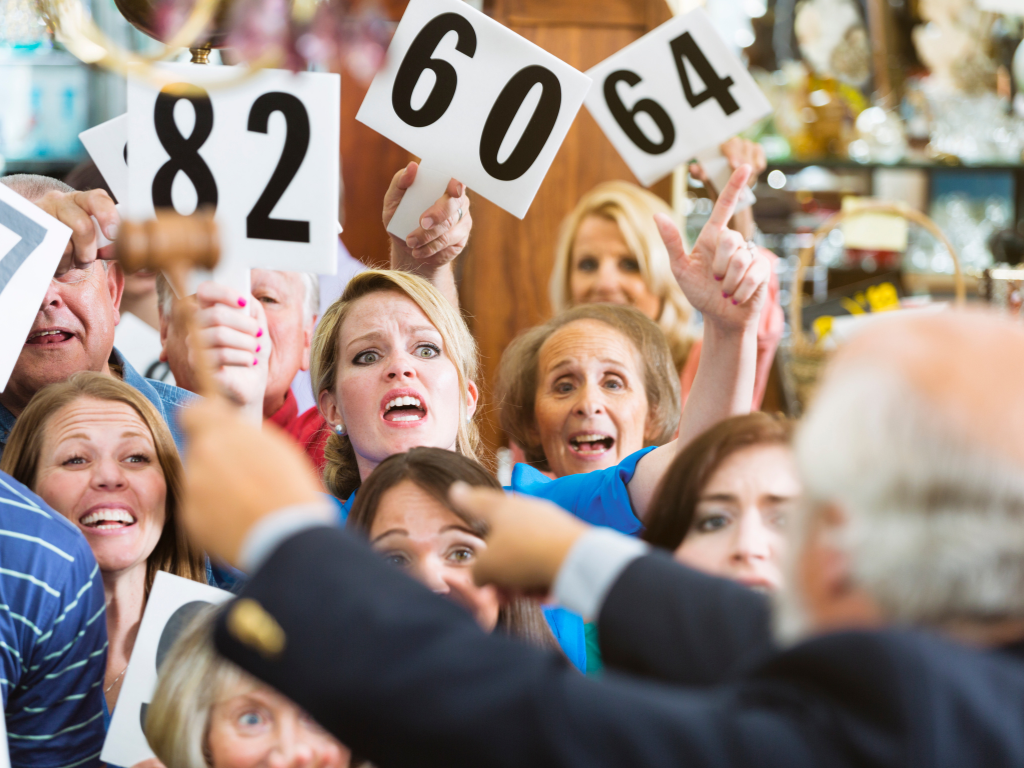
Fostering friendly competition among donors is another benefit of hosting a silent auction fundraiser.
After all, donors may feel motivated to bid higher on an item in order to win it, especially if it’s a highly-coveted item.
One way to increase competition is by highlighting the top bidders and creating a leaderboard of sorts.
This can motivate other donors to bid higher in order to be at the top of the leaderboard and potentially win an item.
Another strategy to foster competition is by creating bidding wars for particularly desirable items.
For example, if there’s a popular item among bidders, you could announce that there are multiple people bidding on the item.
This might inspire them to continue raising their bids in order to win.
By encouraging friendly competition, you can increase your potential revenue and create a fun environment for your donors to participate in.
Additionally, the sense of accomplishment and satisfaction from winning an auction item can lead to increased donor loyalty.
10. Create a Fun and Memorable Event
Creating a fun and memorable event is one of the best benefits of hosting a silent auction fundraiser.
A well-executed event can leave a lasting impression on your donors, making them more likely to remember and support your organization in the future.
To create a memorable event, consider incorporating unique items into your auction, as well as providing food and drinks, music, and other entertainment.
Additionally, incorporating interactive elements into your event can create a more immersive experience for your donors.
For example, you could create a photo booth or other interactive stations for your participants to enjoy between bidding.
Finally, providing opportunities for your donors to connect with each other and your organization can create a sense of community around your event.
For instance, this might include providing opportunities for donors to learn more about your organization’s mission and impact.
It also provides networking opportunities for donors to connect with each other and potential partners.
Silent Auction Rules
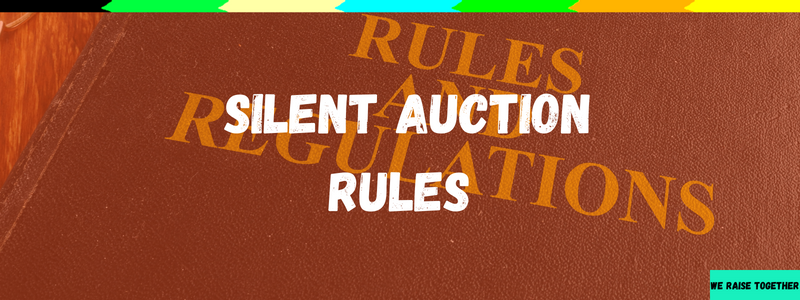
In a silent auction, participants bid on items without the presence of a live auctioneer.
Instead, each item has a bid sheet or app page where participants record:
- Their name
- Contact information
- The amount they’re willing to bid.
The highest bid at the end of the auction wins the item.
Rules for bidding include adhering to the minimum bid increment specified on the bid sheet.
Bidders must also ensure the bid is legible and clearly marked.
Participants must make payment in full at the close of the auction, and winning bidders must collect their items unless other arrangements have been made.
Auction organizers may set a minimum bid for some items, and items with a reserve price must meet that minimum price to be sold.
All items are sold as-is, and descriptions are provided as a courtesy.
Organizers should resolve any disputes during the auction, and their decision is final.
Silent Auction Rule Template
The following is a template you can use for your own silent auction rules:
- Bidding: Bids must be made in writing on the official bid sheet provided by the auction organizers. The bid sheet must include the bidder’s name, contact information, and the bid amount.
- Bid Increments: Bidders must adhere to the minimum bid increment indicated on the bid sheet. Any bid that does not meet the minimum increment will be considered invalid.
- Winning Bids: The highest bidder at the close of the auction will be declared the winner of the item. In the event of a tie, the winner will be determined by a random drawing.
- Payment: Payment must be made in full at the close of the auction. Payment can be made in cash, check, or credit card. All payments are final and non-refundable.
- Item Collection: Items must be collected by the winning bidder at the close of the auction, unless other arrangements have been made with the auction organizers.
- Item Descriptions: All items are sold as-is and the auction organizers make no warranties or guarantees regarding the condition or quality of the items. Item descriptions are provided as a courtesy and are not to be relied upon as a representation of the item’s condition or value.
- Minimum Bid: Some items may have a minimum bid requirement. Bids that do not meet the minimum bid requirement will be considered invalid.
- Reserve Price: Some items may have a reserve price, which is the minimum price at which the item can be sold. If the reserve price is not met, the item will be withdrawn from the auction.
- Right to Withdraw Items: The auction organizers reserve the right to withdraw any item from the auction at any time.
- Disputes: Any disputes that arise during the auction will be resolved by the auction organizers, and their decision will be final.
By participating in the auction, bidders agree to abide by these rules and the decisions of the auction organizers. The auction organizers reserve the right to modify these rules at any time.
How To Throw A Silent Auction
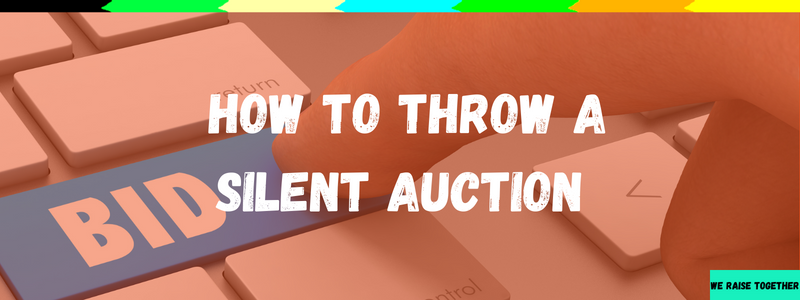
Silent auctions are a fun way to raise money for a good cause.
However, planning and throwing a successful silent auction requires careful attention to detail and a lot of hard work.
In this section, we provide you with some tips and strategies for how to throw a successful silent auction, from creating a planning committee to choosing the right auction items.
So, let’s dive in so you can auction off your first items as soon as possible!
1. Create A Fundraising Team

Creating a fundraising team is essential to the success of your silent auction fundraiser.
A planning committee ensures all aspects of the event are covered, from securing auction items to managing logistics on the day of the auction.
Here are some steps to follow when creating a planning committee.
Identify key roles and responsibilities
Before recruiting members for your planning committee, it’s important to identify the key roles you need to cover.
These might include responsibilities like:
- Auction item procurement
- Event promotion
- Logistics and planning
- Day-of event management
Recruit committee members
Once you’ve identified the key roles, it’s time to recruit committee members.
Look for individuals who are passionate about your cause and have relevant skills and experience in areas such as:
- Fundraising
- Event planning
- Marketing
- Logistics
Consider reaching out to your organization’s existing network of supporters and volunteers.
You might also think about posting about the opportunity on social media and in local community groups.
Set clear goals and timelines
In order to keep the planning process on track, it’s important to set clear goals and timelines for each stage of the process.
This might include goals for:
- The number of auction items to be procured
- Deadlines for securing event sponsors
- Timelines for promoting the event and selling tickets
Hold regular meetings
Regular meetings are essential for keeping your planning committee on track and ensuring you complete all tasks in a timely manner.
Set a regular meeting schedule and make sure all committee members attend meetings as required.
Communicate regularly
Make sure all committee members are aware of key updates and decisions.
Also, encourage open communication and collaboration among all members.
Utilize tools such as email or Google Drive to help facilitate communication and collaboration.
2. Procure Silent Auction Items
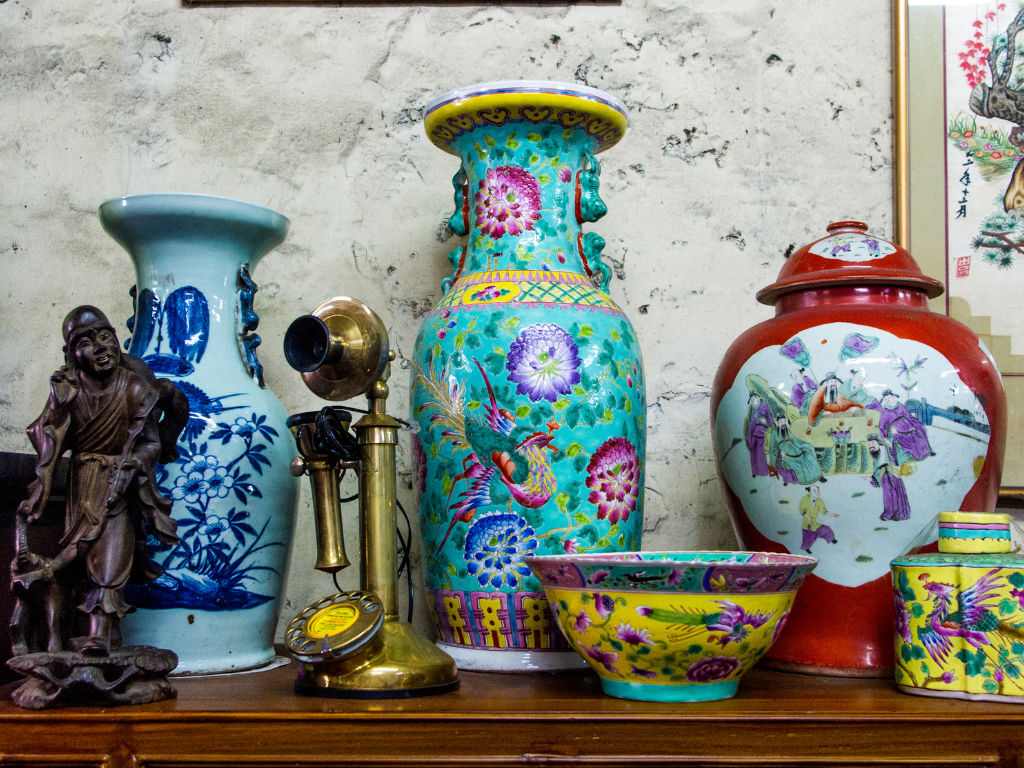
The success of a silent auction fundraiser largely depends on the quality and appeal of the auction items.
To procure auction items, start by brainstorming a list of potential donors. This could include individuals, businesses, or organizations that might be interested in supporting your cause.
You can also reach out to your existing network of supporters to see if they have anything they’d like to donate.
When soliciting donations, it’s important to be clear about:
- The purpose of the fundraiser
- The deadline for donations
- Any guidelines or restrictions for the items donated
You can provide donors with a letter of solicitation outlining this information, as well as a donation form they can fill out to provide information about the donated item.
To make the auction items even more appealing to potential bidders, consider offering a mix of items at different price points.
You can also group items together to create themed packages that may be more appealing to bidders.
Once you’ve collected all of the auction items, keep track of them and organize them in a way that makes them easy to display and bid on.
This may involve creating a catalog of items or creating displays showcasing the items and providing information about them.
3. Promote Your Silent Auction

Promoting your fundraiser is key to maximizing participation and generating interest in the items available for bidding.
Here are a few strategies you can use to promote your silent auction.
Utilize Social Media
Social media can be a powerful tool for promoting your silent auction fundraiser to a wide audience.
Consider creating posts highlighting some of the items available for bidding. Then, encourage your followers to share the information with their friends and family.
You should also think about setting up a dedicated event page or hashtag to make it easier for people to find and share information about the auction.
Finally, you can leverage social media advertising to target specific demographics and promote the auction to a broader audience.
Send Email Invitations
Email invitations are a great way to target your organization’s supporters and encourage them to attend.
Make sure to include all the key details about the fundraiser, including:
- Date
- Time
- Location
- Information about the items available for bidding
Personalize the invitation as much as possible to make the recipient feel valued and appreciated.
Finally, encourage them to forward the invitation to their friends and family.
Use Print Materials
Eye-catching posters and flyers are a great way to promote your silent auction in your local community.
Be sure the materials include all of the key details about the auction and the items available for bidding.
Then, try to place them in high-traffic areas around your community.
Leverage Your Network
Encourage your volunteers and staff to promote the silent auction to their personal and professional networks.
Also, consider partnering with local businesses and organizations to promote the auction, providing incentives for their participation.
Reaching out to local media outlets to feature the auction in their coverage is also a great strategy.
Provide a Preview of Auction Items
Hosting a preview event or creating a digital preview catalog can generate excitement and interest in the auction.
Furthermore, it might encourage people to attend and bid on items.
Think about showcasing some of the most desirable items available for bidding by providing information about each item, including its value and any special features.
4. Set Up The Silent Auction

Once you’ve procured the auction items, it’s time to set up the silent auction. Depending on the size and scope of the fundraiser, this may involve:
- Renting a space
- Setting up tables and displays
- Hiring volunteers to help with the event
To set up the auction, you’ll need to create bid sheets or use a mobile app to facilitate bidding. Bid sheets typically include:
- The name of the item
- A brief description
- The starting bid amount
- Space for bidders to write their name and bid amount
If you’re using a mobile app, you’ll need to choose one that allows for easy bidding and tracking of bids.
Many mobile apps also give you real-time notifications of bids and help streamline the bidding process.
Once you’ve set up the bidding system, it’s important to create displays showcasing the auction items and providing information about them.
This might involve:
- Creating signage
- Setting up tables or display cases
- Making themed displays that group similar items together
To ensure that the event runs smoothly, have volunteers on hand answering questions, monitoring the bidding, and providing assistance.
Volunteers can also help with set-up and tear-down of the event, as well as with collecting payment and distributing items to the winning bidders.
5. Monitor Bidding

During the silent auction fundraiser, participants can browse the auction items and place their bids on the bid sheets or through the mobile app.
Bidding typically takes place over a set period of time, with a predetermined end time and date.
Throughout the bidding period, it’s important to monitor the bids to ensure the process is running correctly.
This may involve checking bid sheets regularly or monitoring the mobile app for updates.
Be sure to address any issues or concerns that may arise right away.
Additionally, establish clear rules and guidelines for bidding so the auction remains fair and transparent. For example, you might:
- Set minimum bid increments
- Establish bidding cutoff times
- Ensure bids are placed in a timely manner
It’s also key to keep track of the highest bids for each item and to notify bidders if someone outbids them.
This may involve updating bid sheets regularly or using a mobile app providing real-time notifications.
6. Close the Auction and Get Paid
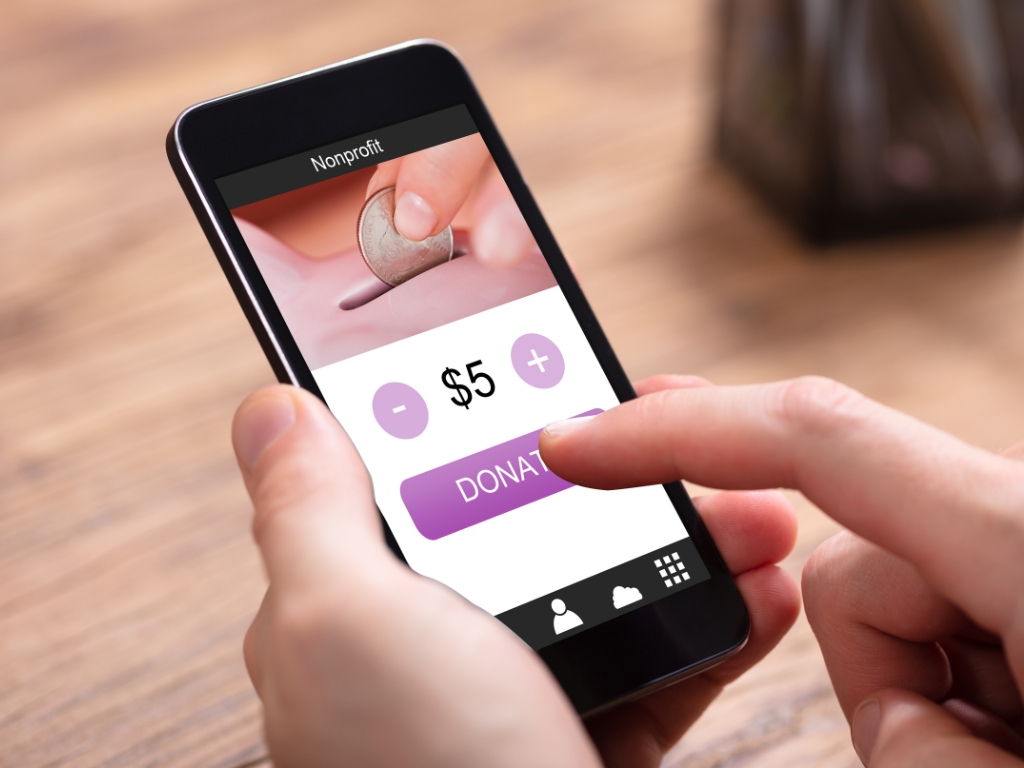
At the end of the bidding period, it’s time to close the auction and collect payment from the winning bidders. This may involve:
- Announcing the winning bids
- Collecting bid sheets or mobile devices
- Verifying the final bid amounts
To facilitate the payment process, you can create an invoice or receipt for each winning bidder outlining the:
- Item they’ve won
- Final bid amount
- Payment options
Depending on the size and scope of the fundraiser, you may be able to collect payment on-site. However, for large-scale events, you may need to provide instructions for how to make payment.
It’s key that auction items are distributed to the winning bidders in a timely manner. So, have volunteers on hand to assist with the distribution process.
Finally, it’s critical to follow up with all participants after the event to thank them for their support.
Additionally, you should provide information about the impact of their donation. To do this, you might want to:
- Send thank-you notes or emails
- Share updates on the success of the fundraiser
- Provide information about future events or initiatives
7. Evaluate Your Silent Auction
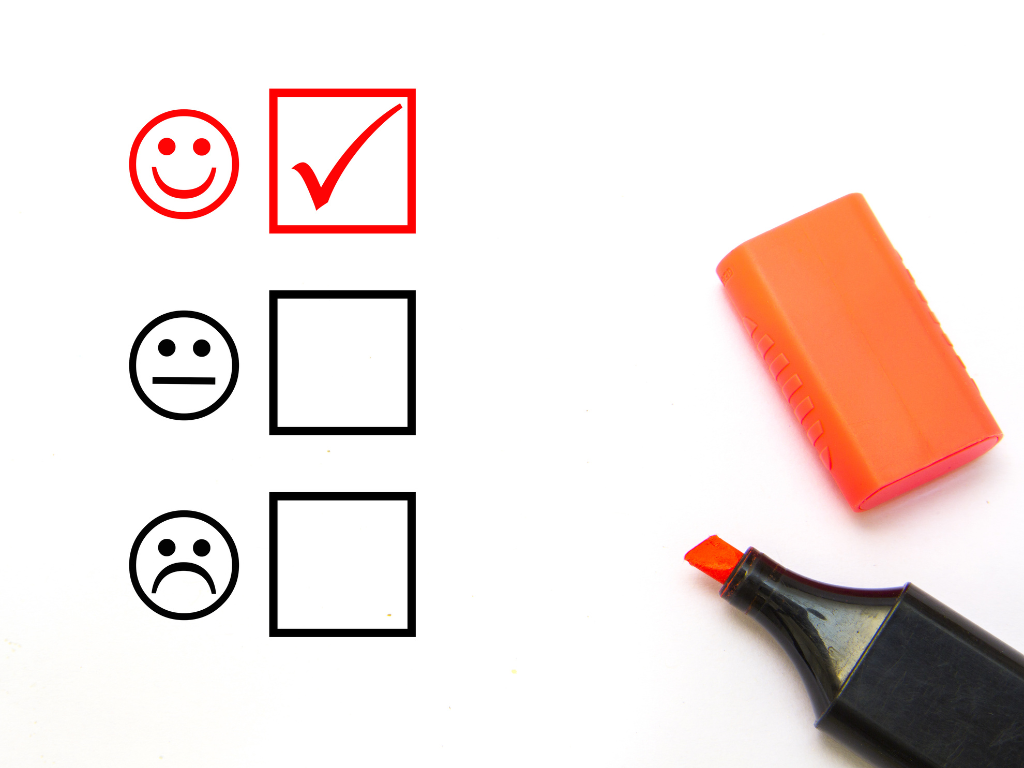
After you close auction and collect all payments, it’s important to evaluate the success of the fundraiser. To do this, you should:
- Analyze the financial results
- Assess the level of participation and engagement
- Identify areas for improvement.
To evaluate the financial results, you should compare the total amount raised to your fundraising goals.
Then, you can assess the return on investment (ROI) of the fundraiser.
Calculate the cost of procuring auction items, renting a space, and hiring volunteers, and compare that to the total amount raised.
To assess the level of participation and engagement, you can:
- Review attendance numbers
- Survey participants
- Consider feedback from volunteers and staff.
This can help you identify areas of strength and weakness and inform future fundraising efforts.
Finally, it’s important to identify areas for improvement and make adjustments to your approach for future fundraisers. For example, you may wish to:
- Refine the auction item selection process
- Adjust the bidding process
- Improve communication and promotion efforts.
By making changes based on feedback and results, you can ensure future fundraising efforts are even more successful!
What Items Sell Best At Silent Auctions?
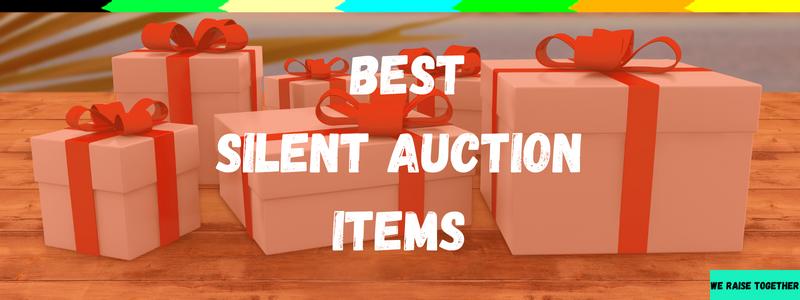
The success of silent auction items can vary depending on factors such as the:
- Audience
- Event theme
- Items’ perceived value
However, here are some popular categories of items that tend to do well at silent auctions.
- Experiences
- Vacation packages
- Tickets to sporting events or concerts
- Spa days
- Cooking classes
- Technology
- Smartphones
- Tablets
- Laptops
- Gaming consoles
- Artwork
- Paintings
- Sculptures
- Photography prints
- Gift Cards and Certificates
- Local Restaurants
- Spas
- Retailers
- Sports Memorabilia
- Autographed equipment
- Balls
- Jerseys
Silent Auction Ideas
The following is a list of silent auction ideas to inspire your own.
Remember, the items that perform best will depend on your target audience and cause.
- Weekend getaway package
- Personal chef experience
- Signed sports memorabilia
- Wine or liquor basket
- VIP concert tickets
- Artwork or photography prints
- Fine jewelry or watches
- Spa day package
- Personal shopping experience
- Golf or tennis lesson with a pro
- Tech gadgets like tablets or headphones
- Fine dining experience
- Sports equipment like golf clubs or tennis rackets
- Custom-tailored suit or dress
- Luxury watch or handbag
- Cooking or mixology class
- Ski or snowboarding trip package
- Yoga or fitness retreat
- VIP sporting event package
- Private movie screening experience
- Music lessons or recording studio time
- Personalized art piece
- Travel package to a popular destination
- Gourmet food or chocolate basket
- Scuba diving or snorkeling adventure
5 Tips For Throwing A Silent Auction
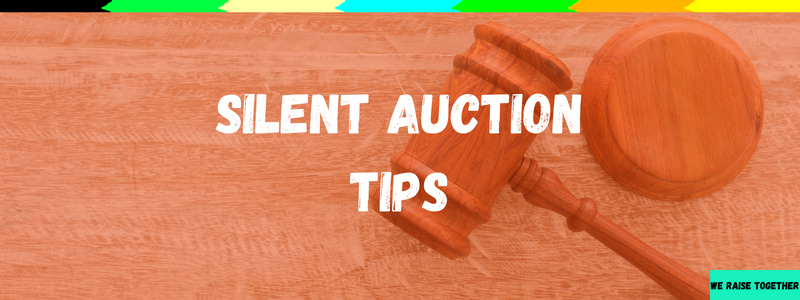
Throwing a successful silent auction fundraiser requires careful planning and attention to detail.
With the right approach, however, it can be a fun and rewarding way to raise money for a good cause.
In this section, we provide you with five essential tips for planing a successful silent auction event.
From using auction software to encouraging competition, these tips will help you to maximize bids and increase donations!
1. Get Items Ahead Of Time

When planning a silent auction, it’s important to start securing items as early as possible.
Don’t wait until the last minute to start gathering items for your auction! This can lead to low-quality items, lowering bids from your donors.
Istead, consider reaching out to local businesses, artists, and other community members for donations early.
You can also ask your existing donor base to donate items, such as tickets to events or other valuable items.
Make sure you have a clear understanding of the types of items that appeal to your donors.
Them, aim to provide a variety of items at different price points to accommodate all budgets.
Finally, try including a mix of items that are both practical and unique to make your auction appealing to a wider range of donors.
2. Utilize Auction Software And Apps
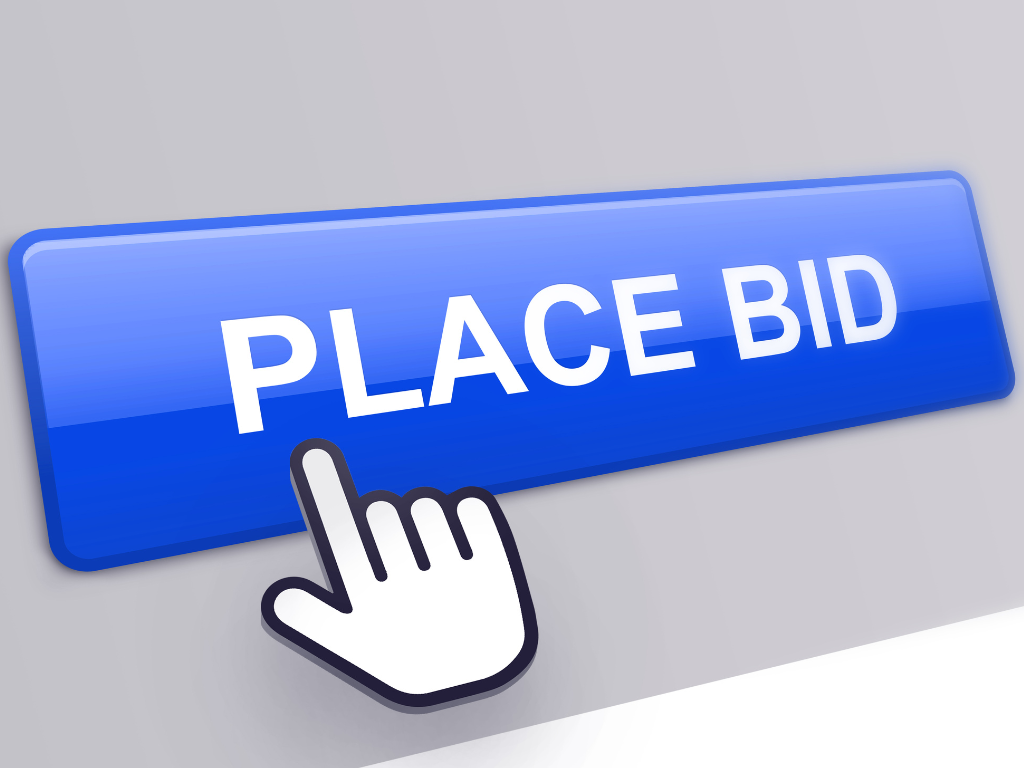
Using auction software and apps can really simplify the process of hosting a silent auction.
There are plenty of software options that allow you to manage the entire auction process from start to finish, including:
- Tracking bids
- Managing item descriptions and photos
- Accepting payments
With auction software, you can create a user-friendly platform for donors to browse and bid on items from anywhere.
Additionally, simplifying the auction process using software and apps helps you track important data, such as:
- Popular items
- How much money was raised
- Which donors were the most active
Be sure to research and compare different software options to find the one that best fits your needs and budget.
We’ll discuss some of your options below.
3. Set Opening Bids

Setting opening bids for your silent auction items is an important step in maximizing your fundraising potential. I
f your opening bids are too low, you risk losing out on potential revenue.
On the other hand, if they’re too high, you may deter donors from bidding altogether.
Consider the value of each item and aim to set opening bids that are reasonable.
You can also research similar items to get an idea of what the market value is and use that information to set your opening bids.
In addition to setting opening bids, you should also establish bidding increments. This ensures your auction is fair and that all donors have an equal chance of winning items.
Remember to clearly display opening bids and bidding increments for each item to make it easy for donors to participate in the auction.
4. Encourage Competition
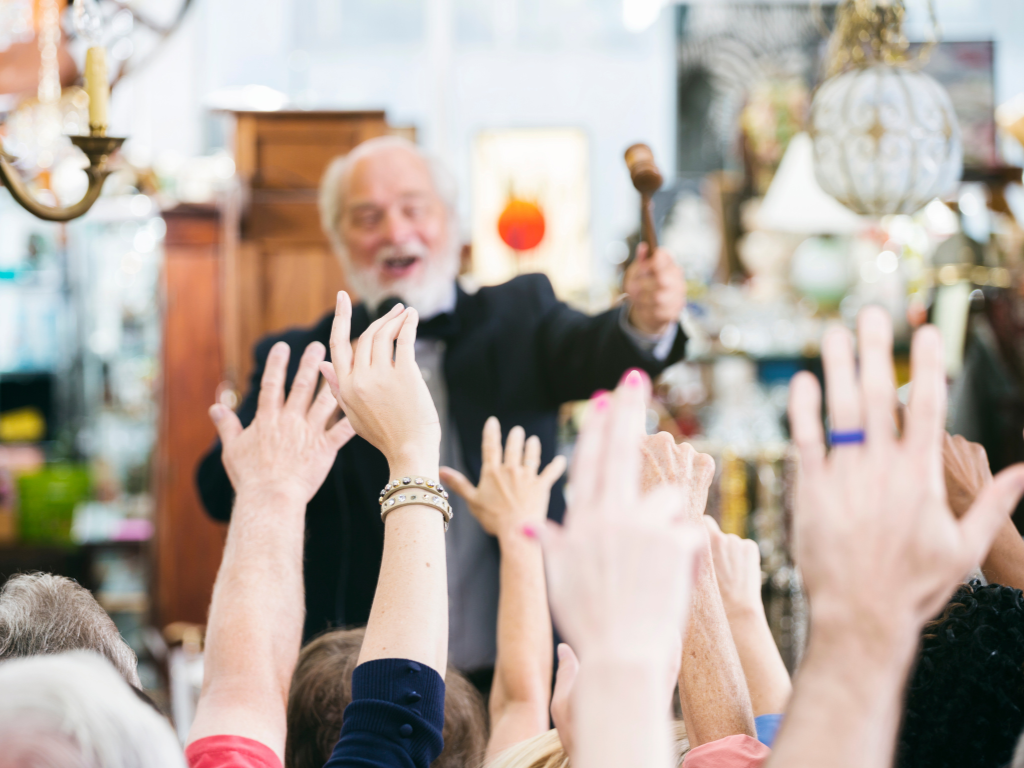
Encouraging healthy competition is a great way to raise more funds at your silent auction fundraiser.
One way to do this is by creating a leaderboard or display showing the top bidders for each item.
This can encourage other donors to bid higher in order to win the item and secure their place on the leaderboard.
Another way to encourage competition is by offering incentives for the top bidders, such as special recognition or prizes. This can create a sense of excitement, encouraging donors to bid more generously.
It’s critical to keep in mind that, while competition is a great motivator, you should maintain a friendly and welcoming atmosphere at your event.
Encourage donors to have fun and participate in the auction at their own pace.
Additionally, remind them that their contributions are greatly appreciated, regardless of the final outcome.
5. Consider The Auction Display

Finally, you should keep the auction display in mind when organzing your event.
When planning your display, consider the layout of the space and the number of items you’ll be featuring.
It’s important to arrange the items in a way that’s easy to navigate, but also visually-appealing.
Consider using signage and labeling to clearly identify each item, and provide important details such as:
- Starting bid
- Minimum bid increment
- Any special instructions or restrictions
Additionally, using lighting and decor to create an inviting and exciting atmosphere can help draw in more donors.
Remember to also consider the safety and security of the items on display.
Be sure to provide adequate security measures to prevent theft or damage.
You may even think about limiting access to high-value items to ensure their safety throughout the event.
Silent Auction Software
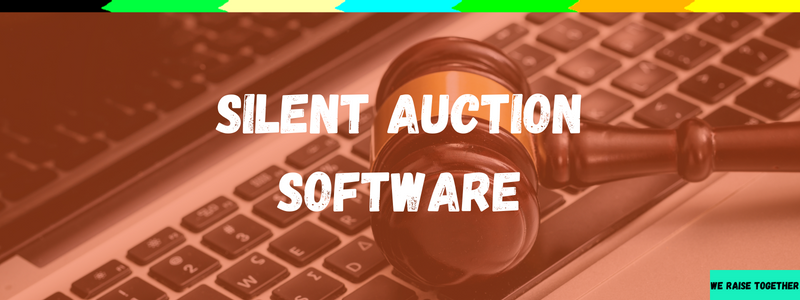
Silent auction software allows you to streamline and simplify silent auction management.
Some key features to look for when selecting silent auction software include:
- Ease of use for both administrators and participants
- Customizable bid sheets
- Real-time bidding updates
- Automated bidding rules
- Secure payment processing
Additionally, mobile bidding is becoming increasingly popular.
Fortunately, many software options offer mobile apps where guests can bid from their phones.
When selecting silent auction software, it’s also important to consider the pricing structure and any associated fees.
You should also think about he level of support and training you may need.
Some software options may require more technical expertise than others. So, it’s important to consider the abilities of your fundraising team when deciding.
Here are some examples of popular Silent Auction software to get you started:
Is A Silent Auction Worth It?
With our comprehensive guide and pro tips, you’re all set to catapult your event to new heights of fundraising success.
Just imagine the buzz in the room as eager participants vie for those auction items you’ve carefully curated.
With an effortless bidding experience, everyone will have a blast, making memories that will last a lifetime!
By following this guide and infusing your event with excitement and competition, your silent auction fundraiser can surpass your goals.
Better yet, it’ll also leave a lasting impression on your community.
So, gear up and let the bidding wars begin!
